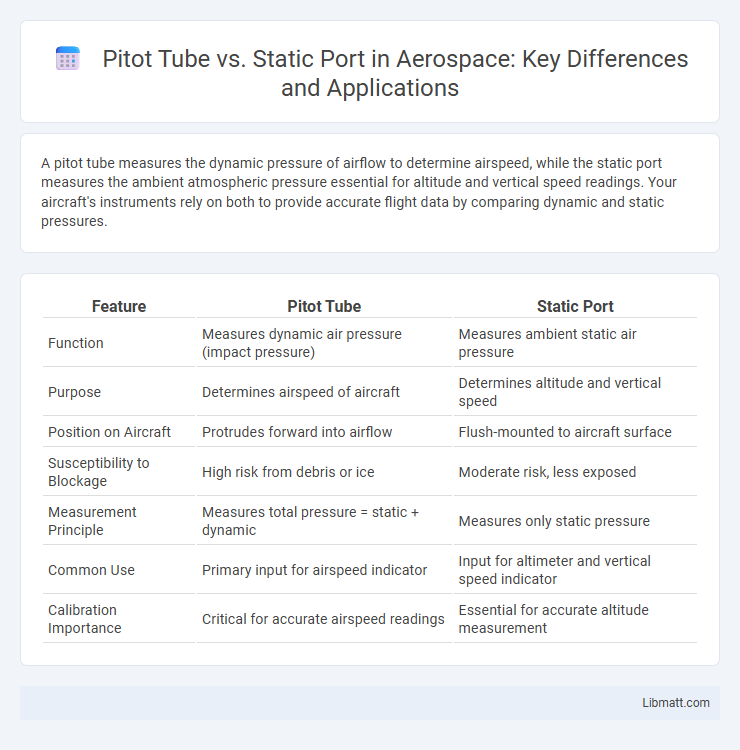A pitot tube measures the dynamic pressure of airflow to determine airspeed, while the static port measures the ambient atmospheric pressure essential for altitude and vertical speed readings. Your aircraft's instruments rely on both to provide accurate flight data by comparing dynamic and static pressures.
Table of Comparison
| Feature | Pitot Tube | Static Port |
|---|---|---|
| Function | Measures dynamic air pressure (impact pressure) | Measures ambient static air pressure |
| Purpose | Determines airspeed of aircraft | Determines altitude and vertical speed |
| Position on Aircraft | Protrudes forward into airflow | Flush-mounted to aircraft surface |
| Susceptibility to Blockage | High risk from debris or ice | Moderate risk, less exposed |
| Measurement Principle | Measures total pressure = static + dynamic | Measures only static pressure |
| Common Use | Primary input for airspeed indicator | Input for altimeter and vertical speed indicator |
| Calibration Importance | Critical for accurate airspeed readings | Essential for accurate altitude measurement |
Introduction to Pitot Tube and Static Port
The pitot tube measures dynamic air pressure by capturing airflow velocity, essential for determining airspeed in aircraft. The static port senses ambient atmospheric pressure unaffected by air movement, providing accurate reference for altitude and vertical speed instruments. Together, these sensors deliver critical data for flight instrumentation systems, ensuring reliable aircraft performance monitoring.
Fundamental Principles: How Pitot Tubes and Static Ports Work
Pitot tubes measure dynamic pressure by capturing airflow directly in a forward-facing tube, allowing calculation of airspeed based on the difference between total and static pressure. Static ports sense the ambient atmospheric pressure without interference from the aircraft's motion, providing essential data for altitude and vertical speed measurements. Understanding how these devices work together is crucial for accurately interpreting your airspeed and altitude instruments during flight.
Key Differences Between Pitot Tube and Static Port
The pitot tube measures dynamic pressure caused by an aircraft's motion to determine airspeed, while the static port measures the ambient atmospheric pressure for altitude and vertical speed calculations. Your aircraft's pitot tube faces forward to capture airflow directly, whereas the static port is mounted flush on the fuselage to sense undisturbed air pressure. Understanding these key differences ensures accurate flight instrumentation and safe navigation.
Applications in Aviation: Pitot Tube vs Static Port
Pitot tubes measure dynamic air pressure to determine airspeed, while static ports measure ambient atmospheric pressure crucial for altitude and vertical speed calculations in aircraft. Pitot tubes are installed facing the airflow to capture ram air pressure, essential for accurate airspeed indication during flight. Static ports are positioned on the aircraft's fuselage to provide undisturbed static pressure readings for instruments like the altimeter and vertical speed indicator.
Accuracy and Reliability: Performance Comparison
Pitot tubes provide dynamic pressure measurements essential for accurate airspeed readings but are susceptible to errors from blockages or air turbulence. Static ports measure the ambient atmospheric pressure, offering consistent baseline data less affected by aircraft movement but vulnerable to errors from position changes or blockages. Combining pitot tube and static port data enhances overall measurement reliability in aviation instruments, ensuring better flight performance monitoring.
Common Errors and Troubleshooting
Common errors with pitot tubes include blockages caused by ice, dirt, or insect nests, leading to inaccurate airspeed readings and potential instrument failure. Static ports often suffer from obstructions or damage that cause incorrect altitude, vertical speed, and airspeed indications, necessitating regular inspection and cleaning. Troubleshooting involves verifying instrument readings against known references, clearing blockages, and ensuring proper installation to maintain precise flight data.
Maintenance Requirements for Pitot Tubes and Static Ports
Pitot tubes require regular inspection and cleaning to prevent blockage from dirt, insects, or ice, which can cause inaccurate airspeed readings. Static ports must be kept clear of debris, paint, and contamination to ensure accurate pressure measurement for altitude and airspeed instruments. Proper maintenance schedules include visual checks and functional tests to ensure reliability and safety in aircraft instrumentation.
Safety Implications of Malfunction
A malfunctioning pitot tube can cause inaccurate airspeed readings, leading to potential pilot misjudgment and flight instability. A blocked static port may result in incorrect altitude and vertical speed indicators, compromising situational awareness. Ensuring both components function properly is critical for reliable flight instrumentation and overall aviation safety.
Innovations and Technological Advances
Innovations in pitot tube and static port technology have significantly improved accuracy and reliability in modern aircraft instrumentation. Advanced materials and aerodynamic designs reduce ice buildup and measurement errors, while integrated sensor systems enhance real-time airspeed and altitude data fusion. Your flight safety benefits from these technological advances by providing more precise environmental readings under varied operating conditions.
Choosing the Right System for Your Aircraft
Selecting between a pitot tube and static port depends on their distinct roles in measuring airspeed and altitude, crucial for safe flight operations. The pitot tube captures dynamic air pressure to determine airspeed, while the static port measures ambient atmospheric pressure, essential for accurate altitude readings. Understanding how each system integrates with your aircraft's instrumentation helps you maintain precision and safety during flight.
pitot tube vs static port Infographic

 libmatt.com
libmatt.com